
by Timothy Oleson Friday, April 14, 2017

Credit: K. Cantner, AGI.
The 1990s was a watershed era in pest control — and, by extension, agriculture — thanks to a particular bit of chemical innovation. With the emergence of a compound called imidacloprid onto the insecticide market, farmers — from those growing rice, corn and other staples, to orchard owners cultivating fruit trees, to backyard gardeners tending vegetable patches — had a powerful new tool with which to combat aphids, beetles, weevils, whiteflies and a host of other insects with a knack for damaging crops.
Developed in the 1980s, imidacloprid was hailed for its potency against nuisance bugs as well as its low toxicity toward other animals, including mammals, fish, birds, soil dwellers like worms, and some insects considered beneficial to plants or ecosystems. Hence, it could be used in lower doses and was relatively safe to handle compared to existing products. It was also versatile.
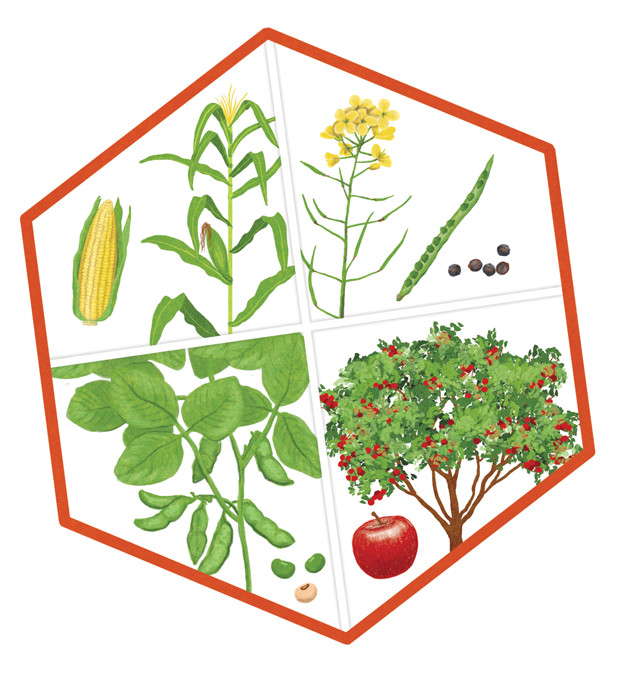
Neonicotinoids are applied to numerous crops — such as (clockwise from top left) corn, rapeseed, orchard fruits like apples, and soybeans — to prevent damage from insect pests. Credit: both: K. Cantner, AGI.
Many pesticides are applied broadly as topical sprays — as in crop-dusting — which can be blown away from treatment areas. Imidacloprid could be applied topically, but it could also be mixed into soil, injected into trees or, most appealing of all, coated onto seeds prior to planting — more direct methods that would, in theory, limit its environmental footprint. It was seen as a win for “precision agriculture.”
After its commercial launch internationally in 1991, sales of imidacloprid — along with a half dozen chemical cousins created since, collectively known as neonicotinoids — gradually grew until the mid-2000s, when neonicotinoid usage ballooned. Amid the rapid growth, however, concerns about their use arose, fanned by possible links between the chemicals and an increase in die-offs among bee colonies around the world starting in about 2006. People began wondering if the compounds were toxic to a wider swath of species than initially thought, and to what extent the chemicals might be escaping into the environment beyond areas where they were being applied.
A decade of investigation into neonicotinoids has since painted a far more complex — albeit still incomplete — picture of their effects on nontarget species. But it has only been in the last several years that efforts have been undertaken to study the distribution, abundance and persistence of neonicotinoids in the environment. Considering that these factors govern the exposure of animals to the chemicals in the real world, and thus the potential risks the compounds pose broadly, much more monitoring is needed, researchers say. Results so far, though patchwork, have shown some consistent trends, suggesting that neonicotinoids — at least as they’re being used currently — may not be so precise after all.
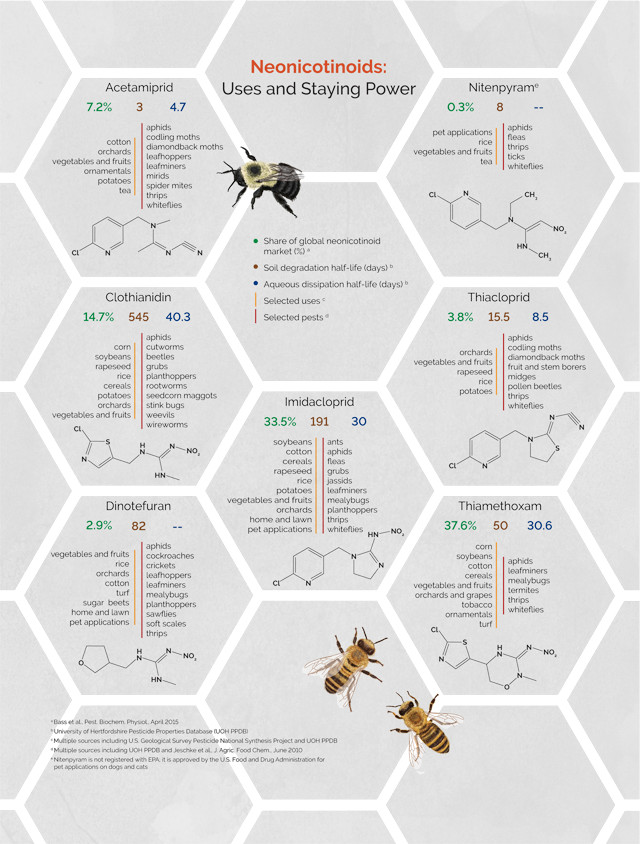
Credit: K. Canter, AGI.
Neonicotinoids work by attaching to proteins involved in neurotransmission called nicotinic acetylcholine receptors. The compounds bind more strongly to these proteins in insects and other invertebrates compared to vertebrates — and, thus, have disproportionately strong effects — with high enough doses causing overstimulation of the nervous system, paralysis and eventually death.
The compounds’ selectively high activity against invertebrates is a major motivation for their use over other leading classes of insecticides like organophosphates, pyrethroids and carbamates, all of which can be highly toxic to fish and/or other vertebrates as well. Another advantage is that neonicotinoids, due to their solubility in water, are taken up by, and distributed throughout, plant tissues. This systemic quality is the key characteristic that allows them to be applied in a variety of ways.
Seven neonicotinoid compounds (listed in order of market share as of 2012) are sold worldwide: thiamethoxam, imidacloprid, clothianidin, acetamiprid, thiacloprid, dinotefuran and nitenpyram (see figure above). Globally, they account for roughly a quarter of the $12-billion-plus insecticide market and about 80 percent of the market for coated crop seeds. Imidacloprid alone is legally registered for a multitude of crop-related uses in more than 120 countries. And aside from combatting insects in farm fields and gardens, the compounds are used to similar effect in treating lawns, mitigating invasive tree-killers, and controlling in-home pests.
In the U.S., where imidacloprid was first registered and sold in 1994, neonicotinoids are registered with the Environmental Protection Agency (EPA) for use in more than 500 applications. Figures for total use across all applications are not readily available. But data collected by the U.S. Geological Survey (USGS), as part of the Pesticide National Synthesis Project, show that use of neonicotinoids in agriculture rose from about 150 metric tons (all imidacloprid) in the late 1990s and early 2000s to between 510 and 625 tons in 2004. From 2004 to 2007, these figures nearly doubled, and in 2012, according to USGS data, between 2,677 and 2,819 tons were used. Data for 2013 and 2014 are still preliminary but suggest the numbers have continued to rise.
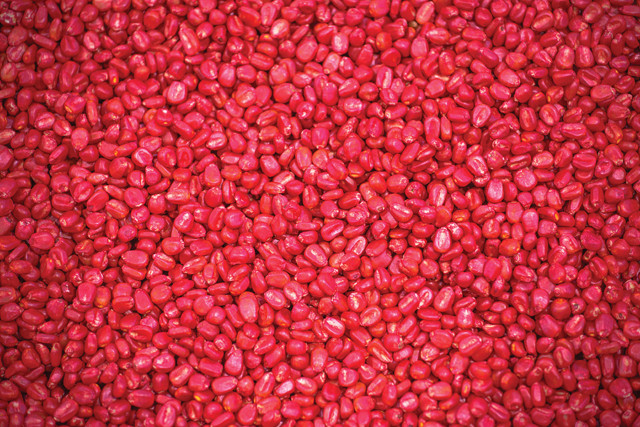
Agricultural seed, particularly for major crops, is commonly coated with neonicotinoid insecticides prior to planting. In the U.S., nearly all neonicotinoid applications to corn, soybeans and wheat — the top three crops by production value — are as seed treatments. Credit: ©iStockphoto.com/stevanovicigor.
“What really drove that mid-2000s increase was … the development of these treated, coated seeds that had the insecticide on them,” says Michelle Hladik, a research chemist and pesticide specialist at the USGS California Water Science Center in Sacramento. Various fungicides and insecticides had been coated onto seeds before, dating back to at least the 1950s. But “this was really the first widespread” application of treated seeds in agriculture, she says.
Roughly 60 percent of neonicotinoid use globally is as soil or seed treatments. And in developed countries, the proportions appear to be even higher: In the U.S., nearly all neonicotinoid applications to corn, soybeans and wheat — the top three crops by production value — are as seed treatments.
When treated seeds are planted, the coatings dissolve into water in the soil. While much of the insecticide remains behind — thought to be between 80 and 98 percent of what’s applied — a portion is taken up with the water into plants, spreading into roots, stems, leaves, nectar, pollen and elsewhere, its efficacy lasting from several weeks to several months. When insects chew on, or suck liquid from, the plants, the chemicals go to work on them.
About a decade ago, some researchers began finding that neonicotinoids were not quite as innocuous to nontarget invertebrates as originally thought. Early studies of the potential toxicity of neonicotinoids — mainly imidacloprid — on such organisms had focused mostly on the water flea, Daphnia magna, a common zooplanktonic crustacean and standard aquatic invertebrate test species. These studies showed that D. magna had very low sensitivity to imidacloprid, with acute lethal effects arising at concentrations in water on the order of 10 to 100 milligrams per liter (mg/L), levels substantially higher than would be expected with recommended usages of the pesticide.
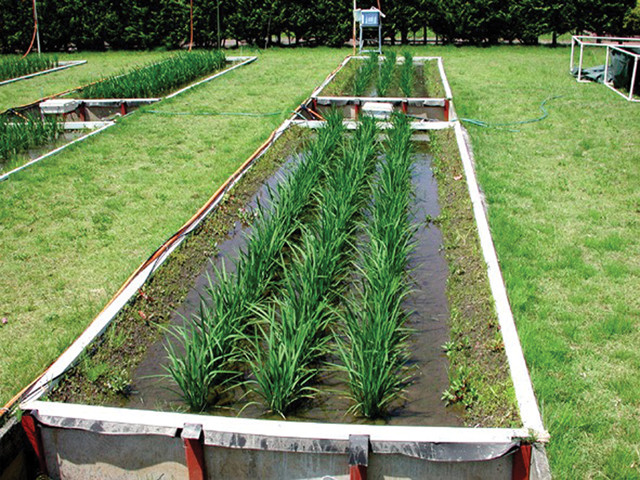
Experimental rice paddies at Japan's National Institute for Environmental Studies were used in a 2006 study investigating the toxicity of imidacloprid to various insects, including nuisance rice weevils as well as aquatic invertebrates not targeted by the insecticide. Credit: Francisco Sánchez-Bayo.
But tests on a wider range of aquatic crustaceans and insects beginning in the mid-2000s started suggesting that neonicotinoids might be more toxic to some of these animals than to D. magna. In one of the first such studies, published in Environmental Toxicology and Chemistry in 2006, Francisco Sánchez-Bayo, an ecotoxicologist then at Chiba University in Japan, and Kouichi Goka of Japan’s National Institute for Environmental Studies, set up experimental paddies of rice plant seedlings, some treated with manufacturer-recommended applications of imidacloprid while others were left untreated as controls. Over four months, they found that in addition to reductions in nuisance rice weevils on the plants, populations of aquatic crustaceans and midges living in the treated paddies’ soils and floodwaters were substantially decreased compared to the control paddies. This was especially true during the first month after planting, when imidacloprid concentrations in the water fell from initial levels of 240 micrograms per liter (μg/L) to about 1 μg/L as most of the insecticide dissipated into the soil — substantially lower levels than what had been found to affect D. magna.
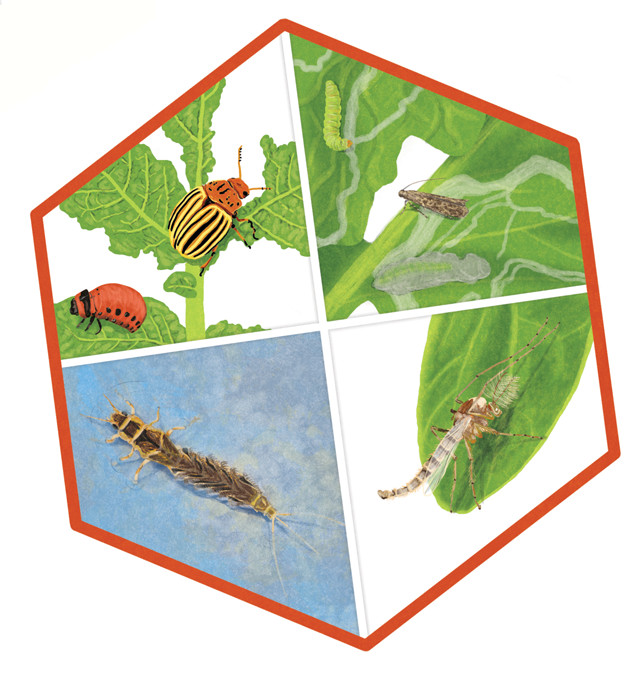
Neonicotinoids are intended to combat numerous insect pests, such as the Colorado potato beetle (top left) and leafminers (top right). However, the chemicals have also been found to be toxic to insects that serve beneficial purposes in ecosystems, such as mayfly nymphs (bottom left) and Chironomus midges (bottom right). Credit: K. Cantner, AGI.
“That was, for us, the first realization … that imidacloprid was toxic to all these little creatures that live in the rice fields,” says Sánchez-Bayo, now an honorary associate at the University of Sydney in Australia. “From then on, many other people started to investigate the toxicity to other crustaceans … and they found exactly the same thing we found: They’re very susceptible to this insecticide.”
In a 2014 review in Environment International, a team led by Christy Morrissey of the University of Saskatchewan, including Sánchez-Bayo, looked at 214 prior toxicity tests of 49 different aquatic crustaceans and insects and concluded that many species appeared to show adverse reactions to acute, short-term exposures to aqueous neonicotinoid concentrations at or well below 1 μg/L. Most pesticides do not have negative effects on ecosystems at such a low threshold, Sánchez-Bayo says, which suggests how potent neonicotinoids can be.
Sublethal effects, such as impaired growth or functioning, also occurred with longer-term exposures to even lower concentrations, the researchers noted in the review. Neonicotinoids “don’t have just an acute [effect] at the moment an animal receives that dose from the water,” Sánchez-Bayo says; there are impacts with chronic exposures as well. “With these creatures exposed for more than one week or two weeks to the same contaminated water, the toxicity increases.”
Die-offs and impairments of tiny aquatic organisms can have ripple effects on ecosystems, Sánchez-Bayo says. Mayfly and caddisfly larvae, for example, which have been found to be especially vulnerable to pesticide pollution in general, he notes, feed on and decompose leaves and other organic material that fall into streams and ponds. “It’s an essential service,” maintaining water quality and keeping waterways from turning turbid. Additionally, as aquatic insects disappear, insectivorous animals like frogs, lizards and birds can be affected, “not because of the toxicity to them from the chemical … but simply because they don’t have food,” he says.
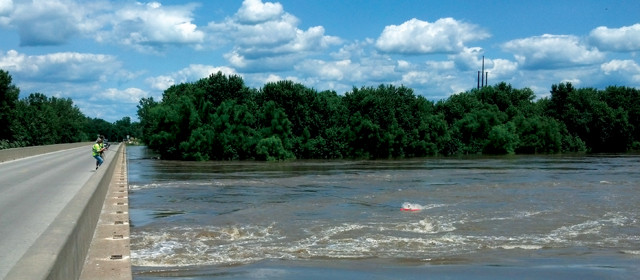
U.S. Geological Survey (USGS) scientists sample the Iowa River during a flood event in July 2014. Credit: courtesy of Michelle Hladik.
Another, broader review published in 2014 in Environmental Science and Pollution Research came to similar conclusions with regard to aquatic invertebrates: Lennard Pisa of Utrecht University in the Netherlands and his colleagues wrote that these organisms are “particularly susceptible to pesticides” because unlike terrestrial organisms, they “generally cannot avoid exposure easily by moving to uncontaminated areas, particularly when pesticides are water soluble.” The review also summarized an abundance of work on neonicotinoid toxicity across a spread of terrestrial invertebrates, noting reports of lethal and sublethal toxicity from short- and long-term exposures to earthworms, beetles, flies, and bumblebees and honeybees — by far the most studied group because of their value as commercial and wild pollinators — among others. For instance, honeybees exposed to sublethal doses have been found to suffer impairments in flight, navigation, learning and larval development.
Despite the negative findings of many studies, the full picture of neonicotinoids’ toxicity — and environmental risks from this toxicity — is not completely established, Hladik says. This is partly because different studies have been looking at different species, as well as different metrics for toxicity, such as mortality, or some level of impact on growth, behavior or reproduction.
Morrissey and her colleagues wrote in their review that the surge in recent toxicity research “has produced a mass of new and useful data, but often with confusing results.” Pisa’s team reported “a major knowledge gap regarding impacts on the grand majority of invertebrates.” In addition to the vast diversity of species studied and the variety of metrics, experimental conditions, such as durations and rates of exposure as well as whether animals were studied in a lab versus in natural settings, also contribute to the uncertainty in reported toxicities.
Beyond questions of neonicotinoid toxicity in different animals, what bears on potential risks of the chemicals are the levels these animals are actually encountering in nature. Combining toxicity data with environmental occurrence data is the way “to get at that ‘so what’ question” of whether concern over neonicotinoid use is warranted, Hladik says. Rigorous efforts to answer the question involve labor-intensive monitoring of waterways, soils and other areas that could be affected.
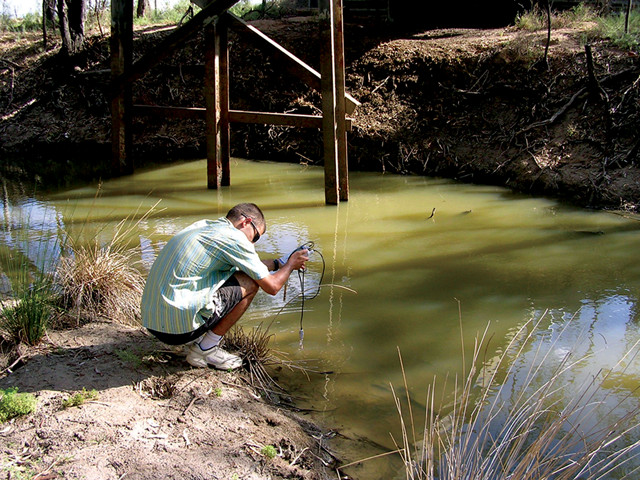
A University of Sydney researcher collects water-quality measurements in a branch of Australia's Macquarie River. Monitoring studies in roughly a dozen countries, including Australia, have detected neonicotinoids in waterways downstream from application sites. Credit: Francisco Sánchez-Bayo.
Escape of aerially delivered pesticides into the environment is virtually inevitable given the various mechanisms — wind, stray dust or unwitting animals — that can carry even well-targeted applications offsite. These chemicals aren’t usually carried far afield, however, at least not at high concentrations, and many degrade and lose their toxicity quickly in soil, water or sunlight.
Neonicotinoids applied as seed or soil treatments are far less likely than aerial pesticides to be blown directly by wind. As seed coatings, they’re “applied to less than 1 percent of [the area of] a field compared to 100 percent if the field were treated with a broadcast foliar spray,” notes David Fischer, director of pollinator safety for the Crop Science division of Bayer, which markets products internationally containing clothianidin, imidacloprid and thiacloprid. “Applying the chemical to the seeds that are planted beneath the surface of the soil eliminates spray drift and minimizes the potential for movement into nearby water bodies,” Fischer says.
Nonetheless, dust-borne transport of neonicotinoids — scuffed off seeds during planting or kicked up from soil during tilling — has been observed, with dust settling on vegetation and into waterways offsite. And although soil often makes a great filter, the compounds’ high water-solubility means that portions not taken up by plants can be dissolved in rainwater, snowmelt or irrigation runoff that drains from fields into streams, ponds and groundwater. Once entrained in these waterways, the chemicals can spread from where they were used.
Further, the most widely used neonicotinoids are persistent in the environment: Figures vary depending on the study, but imidacloprid has been found, for example, to last for months in soils before degrading and weeks in water before dissipating, while others may last even longer. Such residence times raise the prospects of prolonged and widespread exposures to animals, and the potential for the compounds to accumulate in the environment over time.
People “have been measuring imidacloprid in water for years; it just wasn’t being detected a lot or at concentrations that were thought to be of concern, so I don’t think it was getting attention,” Hladik says. But the “increased use, and the change in how it’s used with the seed coatings, really got people interested and concerned that there needed to be more study.”
So far, though, just a few dozen studies — many limited in geography and duration — have presented data from a handful of countries on neonicotinoid abundance and distribution in the environment. In the U.S., imidacloprid was found, for example, in about 90 percent of surface water samples collected during the irrigation seasons of 2010 and 2011 in three agricultural regions of Central and Southern California; in about one-fifth of those samples, the detected concentrations exceeded 1.05 μg/L, the EPA’s current benchmark for aquatic invertebrates, above which chronic exposures to imidacloprid could harm animals in the agency’s estimation. And a 2013 study in Chemosphere, which analyzed water collected in 2005 from playa wetlands adjacent to cotton fields in the Southern High Plains of Texas, detected acetamiprid and thiamethoxam in 17 and 31 percent of samples, respectively, with concentrations at times exceeding the EPA benchmarks for those compounds.
With colleagues at USGS, Hladik has been working to fill in the picture of neonicotinoid distributions across the U.S. “to get better insight into where they’re occurring, especially as they’re getting transported from the field where they were applied to waterways,” she says.
After an initial small-scale study of two Georgia waterways turned up hints of imidacloprid, she turned her sights to Iowa, the leading U.S. producer of corn and soybeans. “We knew that they were using [neonicotinoid] seed coatings for a lot of the seeds that were planted,” Hladik says, so her team wanted to look at the frequency, timing and concentrations of neonicotinoid occurrences.
Throughout the 2013 growing season from early spring through October, Hladik and her colleagues sampled nine stream sites across Iowa that catch water from basins of various sizes and with different extents of agricultural land use. They reported in Environmental Pollution in 2014 that neonicotinoid concentrations in their samples were typically low, averaging less than 0.01 μg/L across all samples, with peaks in May and June not exceeding 0.5 μg/L. But at least one neonicotinoid was detected in 76 percent of the samples, and nearly half contained two or more chemicals.
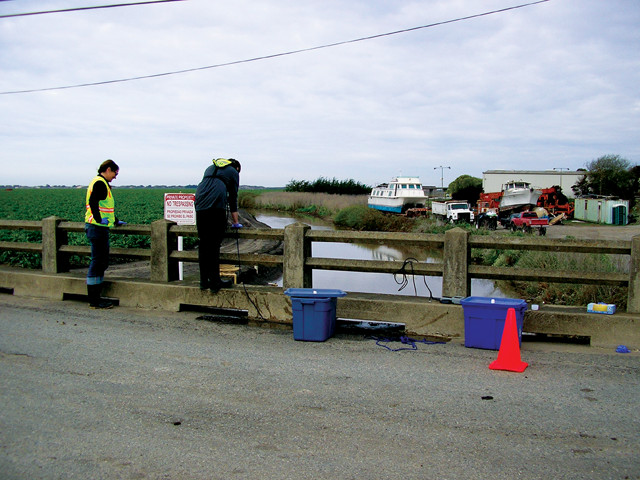
Scientists from USGS and California's Central Coast Regional Water Quality Control Board sample water at Tembladero Slough near Monterey Bay. In a national-scale stream survey, scientists detected the highest total concentration of neonicotinoids in March 2014 at this site, which receives runoff from both agricultural and urban land-use areas. Credit: James Orlando.
“We were detecting them quite frequently at all times of the year,” Hladik says, “but we were getting this increasing concentration and frequency right after planting, which was letting us know that these seed treatments were one of the driving factors.” Additionally, she notes, given the high detection frequency before the year’s seeds had even been sown, “clearly, there is some residual level hanging around in the soil” from year to year.
Building on the Iowa study, Hladik and hydrologist Dana Kolpin of USGS’s Iowa Water Science Center broadened the view further, publishing the first national-scale survey of neonicotinoids in streams across the U.S. in 2015 in Environmental Chemistry. They analyzed water samples collected between fall 2012 and summer 2014 from 48 streams in 25 states plus Puerto Rico; the streams drain areas ranging from 12 to more than 16,000 square kilometers and were known to receive runoff from agricultural and/or urban sources.
The researchers detected at least one neonicotinoid in 63 percent of the samples, with imidacloprid — used for the widest array of applications — appearing most frequently, while 26 percent contained two or more neonicotinoids. The range of concentrations observed was similar to that seen in the Iowa study, averaging 0.02 μg/L across all samples nationwide and topping out at about 0.45 μg/L, measured in March in a California stream draining both agricultural and urban lands near Monterey Bay. Hladik and Kolpin noted that higher concentrations generally correlated with greater proportions of agricultural and urban land use in stream watersheds. Additionally, from sampling in Iowa as well as from a trio of streams draining agricultural areas in the Chesapeake Bay watershed, they reported that neonicotinoid concentrations spiked following rain events during the planting season, results that “confirm that precipitation is an important driver of neonicotinoid transport to streams following periods of use,” they wrote.
Overall, research to date has shown that patterns of neonicotinoid distribution in the environment vary widely, but common themes have emerged. “For the most part, where people have looked, people have found them,” and at different times of the year, says John Tooker, an entomologist and extension specialist in Penn State’s College of Agricultural Sciences who, with his graduate student Margaret Douglas, has examined national trends in neonicotinoid application and studied their use in Pennsylvania.
The compounds have also been detected in a variety of settings — from streams draining agricultural and urban lands, to soils, groundwater, mountain streams, plants surrounding agricultural fields, and even domestic wastewater — with concentration spikes and the specific neonicotinoids detected typically matching usage patterns nearby. And although concentrations observed in the environment have ranged widely, both peak and time-averaged concentrations have at times exceeded levels found to be hazardous to some species.

Neonicotinoids are also used to combat invasive tree pests like the hemlock woolly adelgid, which has ravaged hemlocks in the Great Smoky Mountains (as seen here) and elsewhere in the eastern U.S. Credit: ©iStockphoto.com/ehrlif.
Whether these levels are cause for concern — and how great the concern is — depends on whom you ask. While some groups trumpet potential risks to nontarget animals, others contend that environmental concentrations observed to date are too low to have lasting negative effects on ecosystems, or suggest that environmental accumulation should be limited if the pesticides are used properly and because the chemicals naturally break down over time.
That neonicotinoids were detected frequently in the USGS studies “is not surprising” considering how widely the insecticides have been adopted, Fischer says. “Interestingly, most water-monitoring studies that have looked at [neonicotinoids in the environment] have shown that the residues of these products are far below the safe threshold levels for effects on aquatic life established by the EPA,” he says. caption align=right]
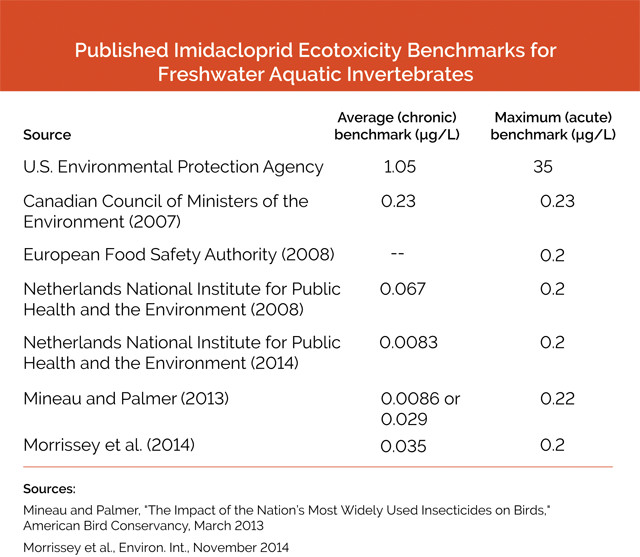
Credit: above.
Adding to the confusion over hazard assessments, however, is the multitude of potentially exposed species with varying tolerances for neonicotinoids, as well as the fact that there’s no uniform environmental safety benchmark for the chemicals. In addition to the U.S., authorities in Canada, the Netherlands and the European Union also have published neonicotinoid benchmarks for aquatic environments (see table). Each reflects different datasets and evaluation criteria, most are specific to imidacloprid only, and all of them are lower than current EPA benchmarks. Researchers including Sánchez-Bayo and his colleagues have also proposed short- and long-term thresholds — each about 100 times lower than the corresponding EPA benchmarks — for neonicotinoid concentrations considered safe for aquatic invertebrates.
For Tooker, “the maximum [concentrations] that are being revealed in some of these papers are very concerning,” even though levels drop off from those maximums after initial neonicotinoid applications. What’s more worrying at this point, though, he says, is how much is still unknown about how chronic exposures to relatively low levels of neonicotinoids affect many insects in the wild. Because of the large number of variables to track, and how mobile animal populations can be, “it’s difficult … to quantify the effect of chronic exposures” in the environment, Tooker says.
Nonetheless, a few teams have begun trying to do just that, moving beyond the laboratory to investigate chronic exposure impacts in the field. Researchers, for example, recently combined 18 years of distribution data for 62 species of wild bees in the U.K. with data on neonicotinoid use on rapeseed crops, reporting in Nature Communications that species that forage on rapeseed were more likely to have experienced population declines than species that do not. In Northern California, a team including Hladik correlated declining butterfly populations at four different sites starting in the late 1990s with increasing neonicotinoid use nearby, as they reported in Biology Letters.
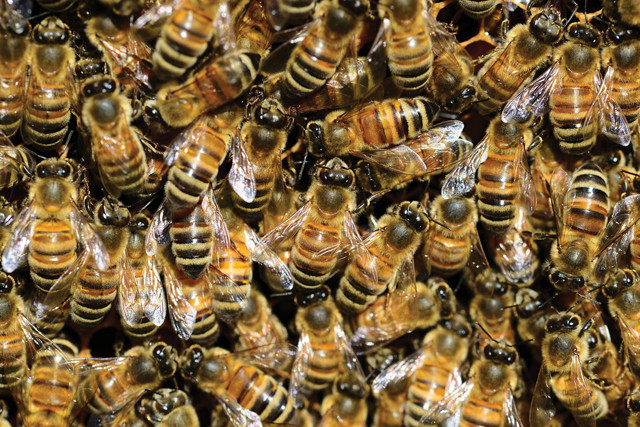
Bees, particularly honeybees because of their value as commercial and wild pollinators, have received the most attention from researchers investigating the acute and chronic effects of neonicotinoids on unintended insect targets. Credit: PollyDot, CC0 public domain.
“The worst-case scenario,” Tooker says, is that chronic exposures are “really simplifying the base of the food web, and that could be evidenced higher up.” If insect populations are killed off, in other words, insect-eating animals could be imperiled.
Studies on the potential ripple effects through the food web are few and far between, and have had mixed results. But in one of the broadest so far, published in Nature in 2014, a Dutch team led by Caspar Hallmann of Radboud University compared nationwide data on bird counts from the Netherlands through the 2000s with imidacloprid concentrations observed in surface waters across the country over the same period. They demonstrated that population declines of about 3.5 percent per year in barn swallows, starlings and several other insectivorous birds common to farmlands were better correlated with long-term average imidacloprid concentrations of 0.02 μg/L or more in surface waters than with a variety of land-use changes also potentially capable of affecting birds.
It “wasn’t a cause-and-effect study, but it was very suggestive [of a connection],” Tooker says. If such declines are “indicative of what can happen when neonics regularly get into groundwater and surface water … I don’t think it’s a stretch to believe the same thing could be happening on a nationwide scale [in the U.S.],” he says. “You can’t assume that it’s happening here, but it’s also not safe to assume that it’s not happening.”
With mounting evidence of neonicotinoids’ effects on nontarget animals and their widespread escape into the environment, “we should be examining these compounds and how they are used so that we balance everything,” Hladik says. “It’s always [about] trying to balance our need to control pests, which is always going to be there, [with] environmental factors.”
As the chemicals have become increasingly prevalent, a question raised more and more is whether they are providing tangible benefits in agriculture. There is little doubt that the compounds can be effective in controlling pest infestations at times, but how beneficial these seed coatings actually are is unclear, Hladik says. “That’s a gap that people are trying to fill.”
In a 2014 report, for example, EPA concluded, based on published data, that “U.S. soybean growers derive limited to no benefit from neonicotinoid seed treatments in most instances,” and “that most usage … does not protect soybean yield any better than doing no pest control.” However, in a 2016 study, researchers who surveyed U.S. soybean farmers reported in Pest Management Science that neonicotinoid seed treatments increased yields by 4 percent on average and added $28 to $42 of value per hectare based on the farmers’ self-reported value estimations and crop-yield data. Similarly convoluted indications have come out of Europe. A 2013 review in the Journal of Applied Ecology pointed to data from the U.K. suggesting that no significant increase in rapeseed yields had occurred there since the introduction of imidacloprid in the ‘90s. But a report commissioned by Bayer and Syngenta — both leading commercial producers of neonicotinoids — and released in January found that the European Commission’s two-year ban on the use of neonicotinoids on pollinator-friendly crops, instituted in late 2013, had caused a 4 percent drop in annual rapeseed yields on average across the European Union, with consequent economic losses.
Mixed signals exist for other crops as well. In addition to shortages of data, the ambiguity with respect to neonicotinoid benefits may also reflect the current approach to their application with the ubiquity of pre-coated seeds.
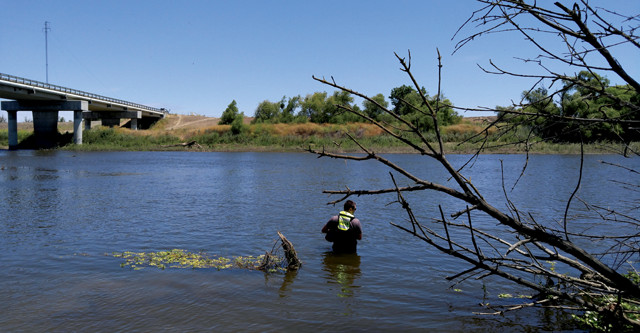
A USGS scientist samples water in the San Francisco Bay Delta for pesticides in June 2016. Credit: Matthew De Parsia.
“What has happened in modern corn, soybean, cotton and wheat production is that it has become a very insurance-based approach to farming,” Tooker says. Neonicotinoids — paid for in the purchase cost of seeds — are being used in abundance largely as a hedge to reduce crop exposure to potential pest threats. For some farmers, he says, there is value in this approach: It offers peace of mind, and also can mean less time spent scouting their land for evidence of looming infestations. And while it undoubtedly pays off sometimes, it also means that neonicotinoids are frequently applied with no immediate threat because the insects targeted tend to be “sporadic and, in many cases, rare,” Tooker says, or they may show up after the protection provided by the chemicals has worn off. The insurance approach also means there are more opportunities for the compounds to be transported offsite.
Different groups have instituted or proposed solutions to mitigate neonicotinoid migration into the environment. In addition to the European Commission’s partial ban, which is currently under review, the government of Ontario began phasing in restrictions on the use of neonicotinoid-coated seeds in mid-2015. Others have, at times, contended that neonicotinoid contamination arises mostly from soil and seed-coating dust transported from farm fields, suggesting that measures to minimize and sequester this dust — such as seed lubricants and deflector shields on planting equipment — can cut down on fugitive transmissions. In 2014, for example, Canada’s national Pest Management Regulatory Agency (PMRA) cited neonicotinoid dust as the main threat to bee health, requiring that such measures be implemented during planting. (Currently, both PMRA and EPA are re-evaluating neonicotinoid risks to bees and aquatic invertebrates, and PMRA has preliminarily proposed phasing out most uses of imidacloprid.)
Another option? Allow use of the chemicals, but realize that “not all crops need to be treated,” Sánchez-Bayo says. “Why do you need to use a seed that is coated … when there is no prediction that there’s going to be a pest in that crop in a certain place?” he asks. “You only treat areas where you see that there’s a problem, not everywhere.”
This approach fits into a broader strategy known as Integrated Pest Management (IPM), Tooker says, which involves combining pest monitoring with various suppression methods — biological, physical and chemical — to tailor pest control based on local conditions. “There is economic value in adopting IPM — economic value in the farmers’ favor that allows them to limit their insecticide use, and that of course limits the impact of any necessary insecticide use on the ecosystems in which they’re being used.”
Whether the economics of IPM eventually prevail over the current insurance-based approach remains to be seen. In the near term, it appears neonicotinoid use will continue to grow. “Adoption rates of insecticidal seed treatments have really been remarkable,” Tooker says, and at the moment, “there’s no reason to think that it’s going to slow.”
So, researchers say, tracking where, how and in what concentrations the insecticides are showing up in the environment will continue to be important in order to keep tabs on potential risks.
© 2008-2021. All rights reserved. Any copying, redistribution or retransmission of any of the contents of this service without the expressed written permission of the American Geosciences Institute is expressly prohibited. Click here for all copyright requests.